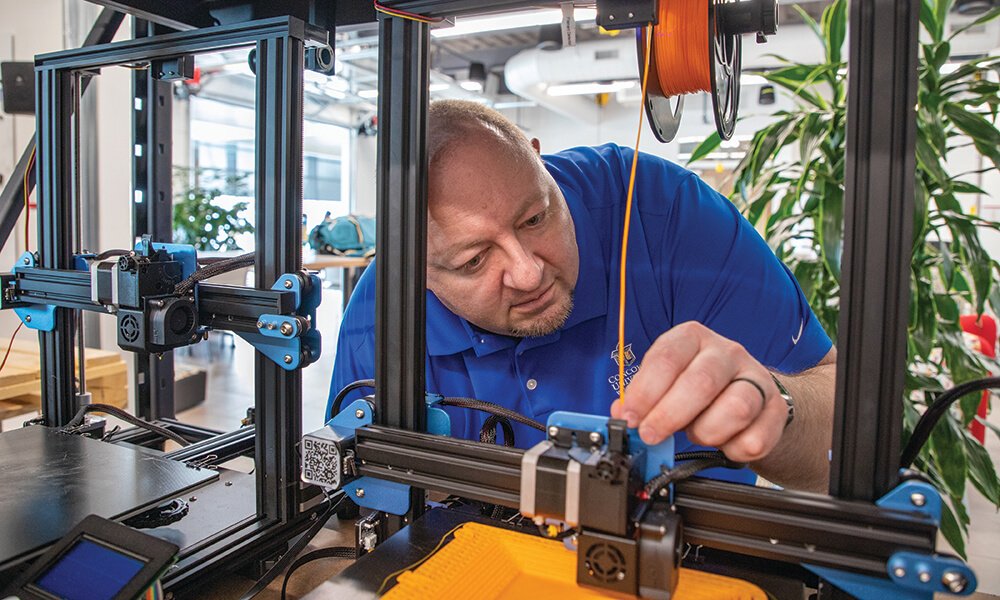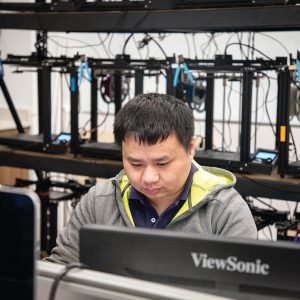
Editor's note: This story first appeared in the spring 2020 issue of the Concordian, the official magazine of Concordia University Wisconsin.
Though open less than a year, Concordia University Wisconsin’s makerspace is poised for students and the broader community to create big things that could change the world, which is fitting because the professor leading this endeavor makes no small plans.
 The term “makerspace” is broadly defined as a dedicated space equipped with tools where people can come together to create a product. Within the past couple of years, makerspace, sometimes referred to as “hackerspace,” has evolved to become synonymous with 3-D printers. While many public libraries, universities, schools, and collaborative workspaces provide access to 3-D printers, CUW’s makerspace offers the most 3-D printers and the largest additive manufacturing capacity in the state.
The term “makerspace” is broadly defined as a dedicated space equipped with tools where people can come together to create a product. Within the past couple of years, makerspace, sometimes referred to as “hackerspace,” has evolved to become synonymous with 3-D printers. While many public libraries, universities, schools, and collaborative workspaces provide access to 3-D printers, CUW’s makerspace offers the most 3-D printers and the largest additive manufacturing capacity in the state.
“I’m a big guy with a big personality, who comes up with big ideas and is willing to take big risks,” explains Mike Litman, PhD, chair of computer science. “God made me to do big things.”
Litman stepped into the role of chair of computer science in July 2019 and has been working on making big improvements to the department, the program, and the overall university culture ever since.
 On the academic side, Litman led significant efforts to revise the computer science curriculum at both the undergraduate and graduate levels. Starting in fall 2020 undergraduates will have the opportunity to select a concentration from the following five options: software engineering, AI and robotics, cyber security, computer animation, and information systems. In addition, the revised program has greater flexibility for more free electives. Graduate students will select from two concentrations: software engineering or information systems. Additionally, a computer science scholars program has been created for qualifying students to earn both a bachelor’s and a master’s degree in computer science in four years.
On the academic side, Litman led significant efforts to revise the computer science curriculum at both the undergraduate and graduate levels. Starting in fall 2020 undergraduates will have the opportunity to select a concentration from the following five options: software engineering, AI and robotics, cyber security, computer animation, and information systems. In addition, the revised program has greater flexibility for more free electives. Graduate students will select from two concentrations: software engineering or information systems. Additionally, a computer science scholars program has been created for qualifying students to earn both a bachelor’s and a master’s degree in computer science in four years.
The computer science program is also partnering with and providing temporary space for the newly announced varsity esports team. Faculty and students are helping the athletic department be ready and equipped for the team’s inaugural year.
Perhaps most visible is the new makerspace located in the heart of the Robert W. Plaster Free Enterprise Center.
CUW’s makerspace includes several standard, industrial, high-end direct drive, enclosed, multimaterial, and large-format 3-D printers, and all of the software and support to learn how to use them.
“Human beings solve problems with the tools that are available to us,” says Litman. “Our vision is to bring together people, whom God created to be great problem-solvers, and give them the tools and the space to get their creative juices flowing.”

The process of creating something is relatively simple. Once one has an idea, the first step is to create a 3-D model using computer-aided design (CAD) software. The model is then formatted for printing using additional software that’s readily available in the space. Depending on the size and material, the printing (or “building”) could take minutes or days to complete. The space is staffed by computer science students and faculty to assist creators at every step.
Important products and solutions will derive from this space, but first users need to know how to use the tools. According to Litman, “Creativity is flowing in the lab. The more comfortable we become, the more useful our creations will be.”

The growing comfort level can be easily tracked through the large display windows that encase the space. Lined up along the shelves is a visual history of the collective learning curve. Creations have evolved from standard tchotchkes, like a replica of the Eiffel Tower, to custom dinosaur skulls and action figures. The most popular creation at the moment is a detailed Baby Yoda.
While Litman enjoys displaying the evolutionary masterpieces, he’s quick to point out that reallife solutions are more important and have also originated from the space. The lab started with small but practical items such as cell phone cases, antique sewing machine replacement bobbins, and coat hangers. Then, with the COVID-19 outbreak, it quickly rose to life-saving applications. Small everyday solutions now that will pave the way to bigger creations.
RELATED: 3D PROTECTION FOR FIRST RESPONDERS
For a leader like Litman, bigger is always better. As he reflects on how he’s fulfilling his purpose at Concordia, he stops for a moment before surmising, “I would say that I’m not big enough, yet. Hopefully one day I will fill that shoe.”
Computer Science Programs Fall 2020
UNDERGRADUATE PROGRAM
All concentrations within the undergraduate program share a revised technology core and include ample room for free electives.
Software Engineering
- Programming 3—data structures
- Systems programming
- Programming language theory
- Theoretical computer science
AI and Robotics
- Coding 3—data structures
- Artificial intelligence
- Advanced artificial intelligence
- Machine learning & robotics
Cybersecurity
- Systems integration
- Cybersecurity
- Networks & security
- Penetration testing
Information Systems
- Systems integration
- Cybersecurity 1
- Networks & security
- Systems programming
Computer Animation
- Systems integration
- Animation 1
- Animation 2
- Animation 3
The spring 2020 Concordian hit mailboxes the end of April. View a PDF version of the magazine here. If you are not on our mailing list, but are interested in receiving a free copy, email Jennifer.Hackmann@cuaa.edu.
— Lisa Liljegren is vice president of marketing and strategic communications.
If this story has inspired you, why not explore how you can help further Concordia's mission through giving.